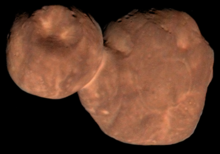太陽系外縁天体
出典: フリー百科事典『ウィキペディア(Wikipedia)』 (2023/02/23 14:35 UTC 版)
探査

2020年の時点では、太陽系外縁天体を主要な対象とした探査ミッションは NASA のニュー・ホライズンズのみである。ニュー・ホライズンズは2006年1月に打ち上げられ、2015年7月に冥王星に接近して観測し[30]、2019年1月にはアロコスに接近して観測した[31]。
2011年には、クワオアー、セドナ、マケマケ、ハウメア、エリスを探査対象として想定した探査機の設計検討が行われた[32][33]。また2019年には、軌道捕獲と複数の探査対象を含む太陽系外縁天体の探査シナリオが提案された[34]。設計検討論文で検討された外縁天体は、(55637) 2002 UX25、1998 WW31、レンポである[34]。
カイパーベルト天体やオールトの雲で観測された特徴、もしくは予測されているいくつかの特徴を説明するための様々な理論的な理由に基づき、地球質量未満から褐色矮星質量の範囲にわたる海王星以遠の天体の存在が予測されている[35][36]。最近になって、探査機ニュー・ホライズンズによる測距データを用いて、そのような仮説上の天体の位置に制約を与えることが提案されている[37]。
NASAは "Interstellar Precursor" として21世紀中の専用の星間探査に向けて取り組んでおり、ある構想では星間物質に到達するように意図的に設計し、その計画の一部としてセドナのような天体のフライバイを行うことも考慮されている[38]。全体としてこれらのタイプの探査機の設計研究では2020年代の打ち上げが提案されており、現在の技術を用いてボイジャーよりもやや高速で飛行させることとしている[38]。Interstellar Precursor に向けて2018年に行われた設計検討では、2030年代にクワオアーを経由する計画が含まれた[39]。
注釈
出典
- ^ a b c d e f “天文学辞典 » 太陽系外縁天体”. 天文学辞典. 日本天文学会. 2020年3月9日閲覧。
- ^ a b “天文学辞典 » 外縁天体”. 天文学辞典. 日本天文学会. 2020年3月9日閲覧。
- ^ Encyclopedia of the Solar System. Elsevier. (2006). p. 584. ISBN 9780120885893
- ^ “List Of Transneptunian Objects”. Minor Planet Center. 2018年10月23日閲覧。
- ^ “List Of Centaurs and Scattered-Disk Objects”. Minor Planet Center (2018年10月8日). 2018年10月23日閲覧。
- ^ “List of Known Trans-Neptunian Objects”. Johnston's Archive (2018年10月7日). 2018年10月23日閲覧。
- ^ “JPL Small-Body Database Search Engine: orbital class (TNO)”. JPL Solar System Dynamics. 2014年7月10日閲覧。
- ^ “JPL Small-Body Database Search Engine: orbital class (TNO) and q > 30.1 (AU)”. 2014年7月11日閲覧。
- ^ C. de la Fuente Marcos; R. de la Fuente Marcos (2014-09-01). “Extreme trans-Neptunian objects and the Kozai mechanism: signalling the presence of trans-Plutonian planets”. Monthly Notices of the Royal Astronomical Society 443 (1): L59–L63. arXiv:1406.0715. Bibcode: 2014MNRAS.443L..59D. doi:10.1093/mnrasl/slu084.
- ^ a b “対外報告 第一報告:国際天文学連合における惑星の定義及び関連事項の取扱いについて” (pdf). 日本学術会議 (2007年4月9日). 2020年3月9日閲覧。
- ^ “天文学辞典 » 海王星以遠天体”. 天文学辞典. 日本天文学会. 2020年3月9日閲覧。
- ^ “天文学辞典 » トランスネプチューニアン天体”. 天文学辞典. 日本天文学会. 2020年3月9日閲覧。
- ^ “Thirty-four years after launch, Voyager 2 continues to explore - NASASpaceFlight.com”. NASA Space Flight. アメリカ航空宇宙局 (2011年8月20日). 2020年3月9日閲覧。
- ^ “Scott S. Sheppard - Farout”. 2020年3月9日閲覧。
- ^ a b Elliot, J. L.; Kern, S. D.; Clancy, K. B.; Gulbis, A. A. S.; Millis, R. L.; Buie, M. W.; Wasserman, L. H.; Chiang, E. I. et al. (2005). “The Deep Ecliptic Survey: A Search for Kuiper Belt Objects and Centaurs. II. Dynamical Classification, the Kuiper Belt Plane, and the Core Population”. The Astronomical Journal 129 (2): 1117–1162. Bibcode: 2005AJ....129.1117E. doi:10.1086/427395.
- ^ a b Brown, Michael E.; Trujillo, Chadwick; Rabinowitz, David (2004). “Discovery of a Candidate Inner Oort Cloud Planetoid”. The Astrophysical Journal 617 (1): 645–649. arXiv:astro-ph/0404456. Bibcode: 2004ApJ...617..645B. doi:10.1086/422095. ISSN 0004-637X.
- ^ Trujillo, Chadwick A.; Sheppard, Scott S. (2014). “A Sedna-like body with a perihelion of 80 astronomical units”. Nature 507 (7493): 471–474. Bibcode: 2014Natur.507..471T. doi:10.1038/nature13156. ISSN 0028-0836. PMID 24670765.
- ^ a b Peixinho, N.; Doressoundiram, A.; Delsanti, A.; Boehnhardt, H.; Barucci, M. A.; Belskaya, I. (2003). “Reopening the TNOs Color Controversy: Centaurs Bimodality and TNOs Unimodality”. Astronomy and Astrophysics 410 (3): L29–L32. arXiv:astro-ph/0309428. Bibcode: 2003A&A...410L..29P. doi:10.1051/0004-6361:20031420.
- ^ Hainaut, O. R.; Delsanti, A. C. (2002). “Color of Minor Bodies in the Outer Solar System”. Astronomy & Astrophysics 389 (2): 641–664. Bibcode: 2002A&A...389..641H. doi:10.1051/0004-6361:20020431. ISSN 0004-6361.
- ^ Doressoundiram, A.; Peixinho, N.; de Bergh, C.; Fornasier, S.; Thébault, Ph.; Barucci, M. A.; Veillet, C. (2002). “The color distribution in the Edgeworth-Kuiper Belt”. The Astronomical Journal 124 (4): 2279–2296. arXiv:astro-ph/0206468. Bibcode: 2002AJ....124.2279D. doi:10.1086/342447. ISSN 00046256.
- ^ 小林浩「太陽系の外縁部での出来事」(pdf)『遊星人』第14巻第2号、2005年、44–49頁。
- ^ Gulbis, Amanda A. S.; Elliot, J. L.; Kane, Julia F. (2006). “The color of the Kuiper belt Core”. Icarus 183 (1): 168–178. Bibcode: 2006Icar..183..168G. doi:10.1016/j.icarus.2006.01.021.
- ^ a b Rabinowitz, David L.; Barkume, Kristina; Brown, Michael E.; Roe, Henry; Schwartz, Michael; Tourtellotte, Suzanne; Trujillo, Chad (2006). “Photometric Observations Constraining the Size, Shape, and Albedo of 2003 EL61, a Rapidly Rotating, Pluto‐sized Object in the Kuiper Belt”. The Astrophysical Journal 639 (2): 1238–1251. arXiv:astro-ph/0509401. Bibcode: 2006ApJ...639.1238R. doi:10.1086/499575. ISSN 0004-637X.
- ^ Fornasier, S.; Dotto, E.; Hainaut, O.; Marzari, F.; Boehnhardt, H.; De Luise, F. et al. (October 2007). “Visible spectroscopic and photometric survey of Jupiter Trojans: Final results on dynamical families”. Icarus 190 (2): 622–642. arXiv:0704.0350. Bibcode: 2007Icar..190..622F. doi:10.1016/j.icarus.2007.03.033.
- ^ Barucci, M. A.; Peixinho, N. (2006). “Trans–Neptunian objects' surface properties”. Proceedings of the International Astronomical Union 1 (S229): 171–190. doi:10.1017/S1743921305006733. ISSN 1743-9213.
- ^ “Conversion of Absolute Magnitude to Diameter”. 小惑星センター. 2020年3月10日閲覧。
- ^ Brett Gladman. “Evidence for an Extended Scattered Disk?”. Observatoire de la Cote d'Azur. 2020年3月10日閲覧。
- ^ Jewitt, D.; Delsanti, A. (2006). “The Solar System Beyond The Planets”. Solar System Update : Topical and Timely Reviews in Solar System Sciences (Springer-Praxis ed.). ISBN 978-3-540-26056-1
- ^ Gomes, Rodney S.; Matese, John J.; Lissauer, Jack J. (2006). “A Distant Planetary-Mass Solar Companion May Have Produced Distant Detached Objects”. Icarus 184 (2): 589–601. Bibcode: 2006Icar..184..589G. doi:10.1016/j.icarus.2006.05.026.
- ^ “New Horizons: The First Mission to the Pluto System and the Kuiper Belt | NASA”. NASA. 2020年3月10日閲覧。
- ^ “New Horizons Successfully Explores Ultima Thule”. ジョンズ・ホプキンズ大学 (2019年1月1日). 2020年3月10日閲覧。
- ^ McGranaghan, R.; Sagan, B.; Dove, G.; Tullos, A.; Lyne, J. E.; Emery, J. P. (2011). “A Survey of Mission Opportunities to Trans-Neptunian Objects”. Journal of the British Interplanetary Society 64: 296–303. Bibcode: 2011JBIS...64..296M.
- ^ “A Survey of Mission Opportunities to Trans-Neptunian Objects” (英語). ResearchGate. 2019年9月23日閲覧。
- ^ a b “AAS 17-777 LOW-COST OPPORTUNITY FOR MULTIPLE TRANS-NEPTUNIAN OBJECT RENDEZVOUS AND ORBITAL CAPTURE” (英語). ResearchGate. 2019年9月23日閲覧。
- ^ Julio A., Fernández (January 2011). “On the Existence of a Distant Solar Companion and its Possible Effects on the Oort Cloud and the Observed Comet Population”. The Astrophysical Journal 726 (1): 33. Bibcode: 2011ApJ...726...33F. doi:10.1088/0004-637X/726/1/33.
- ^ Patryk S., Lykawka; Tadashi, Mukai (2008-04). “An Outer Planet Beyond Pluto and the Origin of the Trans-Neptunian Belt Architecture”. The Astronomical Journal 135 (4): 1161–1200. arXiv:0712.2198. Bibcode: 2008AJ....135.1161L. doi:10.1088/0004-6256/135/4/1161. ISSN 0004-6256.
- ^ Lorenzo, Iorio (2013-08). “Perspectives on effectively constraining the location of a massive trans-Plutonian object with the New Horizons spacecraft: a sensitivity analysis”. Celestial Mechanics and Dynamical Astronomy 116 (4): 357–366. arXiv:1301.3831. Bibcode: 2013CeMDA.116..357I. doi:10.1007/s10569-013-9491-x.
- ^ a b Leonard David (2019年1月9日). “A Wild 'Interstellar Probe' Mission Idea Is Gaining Momentum | Space”. Space.com. 2020年3月11日閲覧。
- ^ Bradnt, P. C.. “The Interstellar Probe Mission (Graphic Poster)” (pdf). hou.usra.edu. 2019年10月13日閲覧。
- ^ Wall, Mike (2011年8月24日). “A Conversation With Pluto's Killer: Q & A With Astronomer Mike Brown”. Space.com. 2016年2月7日閲覧。
- ^ Brown, Michael E. (2010年10月28日). “There's something out there – part 2”. Mike Brown's Planets. 2016年7月18日閲覧。
太陽系外縁天体と同じ種類の言葉
- 太陽系外縁天体のページへのリンク